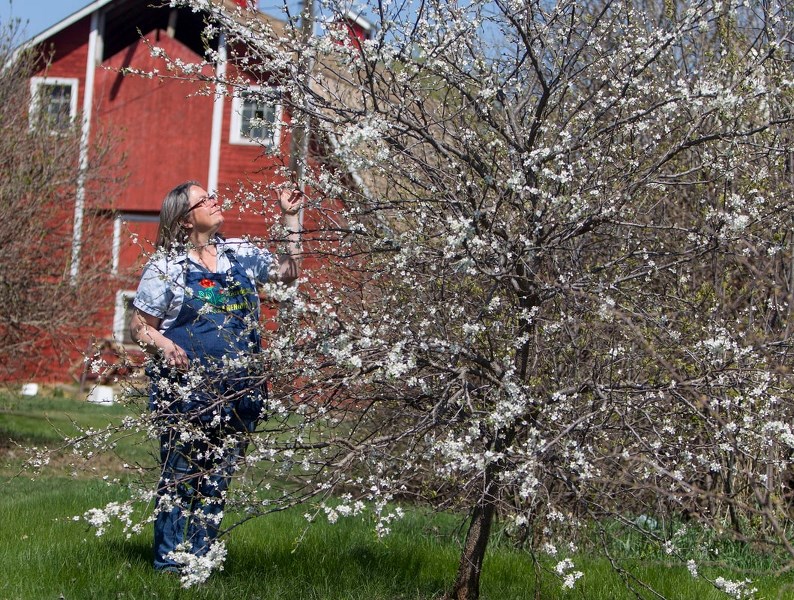It used to be if you wanted a variety of apples in your own yard you had to plant a number of trees, do some selective grafting or perhaps move to British Columbia, but now growing fruit is easier than ever for Prairie gardeners.
It used to be if you wanted a variety of apples in your own yard you had to plant a number of trees, do some selective grafting or perhaps move to British Columbia, but now growing fruit is easier than ever for Prairie gardeners.
“This year we have graft apples,” said Jim Hole of Hole's Greenhouses and Gardens.
Hole counted a total of six different apple varieties growing on one eight foot tree: Haralson, Honey Crisp, Parkland, Harcourt, Heyer and Hardy Macs.
“They are all eating apples,” said Hole, who estimated the tree would reach a final height of approximately 4.5 metres.
Apples that have been grafted are interesting to look at in the spring and fall. In spring, the Macs will have a darker pink blossom, while some of the others will be a pale rose-colour or white. In fall you will have different sizes of apples, all tasting slightly different from each other and ripening at different times. The fun part is you only have to pick them off of one tree.
Growing fruit is more and more popular, said Tam Andersen of Prairie Gardens and Greenhouses. Andersen, who owns a U-pick strawberry and pumpkin farm near Bon Accord, attributes the new-again popularity of home-grown fruit to a wish for organic produce.
“People want their own fruit so their kids can go out and pick some that is organic and home grown,” she said.
Andersen likes the Winter Cheeks variety of apples.
“They are a deep red and about the size of a McIntosh apple with a crunchy inside that is as white as snow,” Andersen said.
If you have a smaller yard, try a dwarf apple such as Goodland.
“Goodland was rated by the Alberta Fruit Growers Society as the best eating apple. It's good in pie or apple sauce and gets a little sweeter after the first frost. It's a green apple with a reddish shoulder,” Andersen said.
Strawberries are one fruit that can be grown in pots as annuals or in the ground as perennials that come back year after year.
“In fruit trials the Cavendish strawberry has been shown to be one of the heaviest producers. You might get two pounds of strawberries per plant. Another to try is the SeaScape variety,” she said.
One of the earliest fruits to ripen is the Haskap honeyberry, which can be harvested in early June. Haskap honeyberries are native to Russia and were developed by Saskatchewan fruit growers, Andersen said.
“They are hardy to minus 40. The fruit is light yellow and two varieties to try are Borealis and Cinderella. They grow about two metres tall. But you have to keep a close eye on them because the robins like them too and if you miss them, the birds will get them first,” Andersen said.
Less hardy, but interesting as annuals, are the Brazelberries sold at Canadian Tire this year.
“They are in the blueberry family and grow about one metre high so they are nice shrubs in large containers,” said Canadian Tire greenhouse manager Tammy Morin.
Other borderline-hardy fruit-bearing plants include a fig tree and a tree that's a combination of a peach and nectarine.
“They are hardy to Zone 3, and we are Zone 5, but you might have luck with them in a protected place in your yard. Or you could grow them on your deck in the summer, and take them inside in the winter,” Morin said.
Saskatoons and nuts
Saskatoons are one of the easiest fruits to grow, as long as you have a sunny location for them. Saskatoon breeders now boast more than 25 different varieties of these prairie favourites.
“I'm excited this year about a Martin saskatoon, because they are among the fastest ripening and the whole cluster ripens at once. Thiessen saskatoons are one of the traditional varieties and they are best known for their large berries,” Andersen said.
If you feel like growing something unusual, try planting butternut or black walnut trees.
Andersen admitted she has never eaten a butternut or grown a black walnut but is intrigued by their possibilities because the trees are so attractive.
“The butternut would have to be planted in a protected area. It has long fronds for leaves and the butternuts are encased in a green skin that looks a little like a kiwi. Eventually the tree will get 25 metres tall.”
Black walnuts are known for their beautiful wood, but the trees are very slow growing.
“You might plant one now for a baby and in 75 years, when the tree is full grown, it would be a financial investment. If you could bring yourself to cut it down, in today's dollars, a full-grown tree would be worth about $15,000. It takes at least 10 years for it to produce nuts, but they are said to be delicious,” Andersen said.
